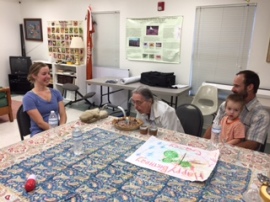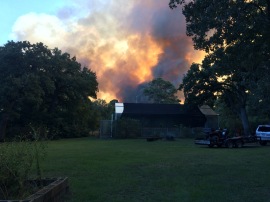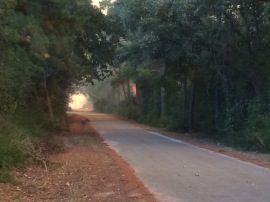Stengl "Lost Pines" Biological Research Station
Just another WordPress.com weblogCanebrake Rattlesnake
A couple of weeks ago (July 17, 20170) I was fortunate enough to record the first sighting of a Canebrake or Timber Rattlesnake (Crotalus horridus) at SLP. This strikingly colored individual was a young adult, roughly 30 inches long. The last 4-6 inches of the tail appeared solid black, but upon close inspection shades of pattern were visible, as were three distinct rattles.
As is common to this species, it did not rattle while I was near. Instead, it first flattened its body and held motionless. After I intruded on its space in an attempt to get better photos, it eventually chose to glide away into the forest. The entire interaction lasted less than a minute, and was hastened by several loud claps of thunder and a brief rain shower.
This was an exciting record for the field station, not only because it was the first, but also because of the status of the snake. Due mainly to habitat loss, the Canebrake rattlesnake is listed as a threatened species. This sighting provides yet another example of the value of maintaining a field station in a wild setting with large scale undisturbed habitat. While some may just see a snake, I see a signal of a healthy and complete ecosystem, prime for research and study in all it’s glory.



Happy 98th!
A few weeks ago we had the opportunity to help Dr. Casey Stengl celebrate her 98th birthday. It was wonderful to have her visit SLP and share the special day with us. So how do you celebrate such a day? Dewberry pie, of course!
Exciting News!
It’s official. As of October 14, Stengl Biological Field Station has expanded to more than double it’s original size. Thanks to a very generous donation from Dr. Casey Stengl, we have been able to acquire an additional 368 acres. The new property is adjacent to our old North fence line and makes the field station now close to one square mile (576 acres).
This addition provides much more value than just more space. Due to it’s varied historical land use, the new area provides us with exciting new research opportunities. Additionally, we can now allow researchers to manipulate plots without loss of our mature, climax state, forested areas.
Also, the new area adds five novel soil types, not previously found at our field station providing further research and teaching opportunities.
Another reason this new addition is important to the future of the field station is that it secures our existing watershed. The headwaters of JD Creek and most of the sheet flow that fills our pond, all start on the new property. Had that ever been compromised due to development or some other drainage altering change, SLP would have lost it’s riparian habitat and associated research.
There are many other new benefits and opportunities this acquisition will provide and I’m excited to share them with you as they come to fruition. For now, I just want to get the news out.
Also, I’d like to thank Dr. Casey Stengl for not only having the generosity to provide funding for this new development, but for having the foresight to initiate the discussion in the first place. This expansion of habitats and resources greatly increases our ability to become a top-notch template for research and teaching.
Hidden Pines Fire
On Tuesday October 16, 2015 I received a phone call from a neighbor asking if everything was alright at the station. She was concerned because she noticed smoke from a large fire near SLP. I had been working on the west side of a building and had not yet noticed the growing plume of smoke. Once I stepped around the corner I saw why she was concerned. About a mile to the east, there was the beginnings of a large wildfire.
I hurried to the backside of our property where we share a fence with the Lueke Ranch. When I arrived it was clear that there was a large fire quickly growing in size and headed towards SLP. At first I could only see encroaching smoke and an ominous glow.
Moments later, as it reached the edge of the pines nearest our property, the flames became apparent.
The winds at this time were blowing moving the fire west, straight towards SLP. I began to hear a mechanical rumble over the roaring, crackling sounds the fire was making. Just then I saw a large bulldozer making its way out of the trees. It began to cut a fire break across the meadow that separated the flames from my vantage point at the east fence of SLP.
Just when it appeared that the fire break was going to contain the fire, the winds shifted and began moving the fire south-west, outpacing the work of the bulldozer.
By this time, the Star Flight and DPS helicopters had begun to drop loads of water, in a futile attempt to slow it’s progress. They were filling up at a large stock pond in the meadow east of SLP.
Once the fire had flanked this bulldozer and small ground crew, my stomach turned. I knew at that point they had lost any chance of preventing this fire from becoming a large scale disaster. The fire continued a south-westerly march consuming property to the south of SLP. Throughout the night the growth slowed as the winds calmed.
Wednesday morning things didn’t appear to be much different and I had regained hope that the fire crews would be able to set up a defensible line to contain growth throughout the day. By noon, it was clear that was not the case. The wind had picked up an changed direction. The fire now moved due north, again bearing down on SLP. Attempts to hold the blazes at the power line cut on Old Antioch failed. The fire was coming and it seemed would be here soon. Looking south toward the greenhouse I could see my neighbors’ homes go up in flames.
At this time I had already packed things I felt could not be replaced and began emergency fire mitigation, removing all items away from the sides of the buildings and raking any leaves or pine needles far away. These steps and others felt futile, but my hope was to make it as hard as possible for the fires to reach the buildings and to give the fire crews the best possible chance to defend them. Fortunately, in the proceeding weeks I had been running the newly installed irrigation system and there was nice green grass around all of the buildings. Just maybe, that would provide the buffer needed to save the buildings.
I had done all I could do, it was time to leave. As I was pulling out of the driveway looking towards Old Antioch and Broken Tree, I could see a ball of fire racing through the opening. I wasn’t the only one fleeing. Deer were bolting out of the forest, using my same escape route to the north.
Just about the time I was evacuating, the winds shifted yet again pushing the fire to the north-west. The small corner of SLP on the opposite side of Old Antioch had been churned up by bulldozers and been made into an impromptu safe zone for the fire crews. The part that wasn’t turned to bare earth burned. On the main part of the property the fire had only clipped the south-west corner of SLP before a bulldozer was able to create a break in our South meadow stopping the northward advance, and eastward back burn. This and the change in the winds saved SLP.
My first hand account ends here, as I was unable to return until Monday October 19. Sheriff’s Deputies strictly enforced the mandatory evacuation. The fires continued to burn out of control until at least Friday. Full containment wasn’t declared until the following week. By then details had emerged about the extent of the damage. 4582 acres and 77 buildings, including 64 homes had burned. Some say that means it is not as bad as the Bastrop Complex Fire of 2011. To those affected by the Hidden Pines Fire, it is just as devastating if not worse. For perspective and context I have added a satellite image illustrating the footprint of the burn. The red rectangle is SLP.
Memorial Day Floods
The field station felt the impact from the floods the week of Memorial Day 2015. JD Creek swelled to levels I have never witnessed, lifting our bridge from its footing. Many feet of fence have been destroyed by floating debris. Our perimeter road is washed out in many places as well.
Despite this, we feel we got off pretty easy compared to many of our Central Texas neighbors.
Welcome Back
Times have been tough for native ant species, especially those that prefer open habitats. Increased competition from invasives, specifically the red imported fire ant, Solenopsis invicta, have made many native species more and more scarce. Last week I found evidence that at least one native species appears to be holding on despite this competition.
For the first time in years, I found a newly forming harvester ant colony here at Stengl. This species, Pogonomyrmex comanche, shares the same habitat preference as the imported fire ants, open areas with little canopy cover. The appearance of these natives, shows they are colonizing the area (from aerial mating flights) despite heavy presence of fire ants.
This is very encouraging because it is something we have not seen here in quite some time. It is unknown whether this has happend due to ongoing bio-control efforts against the fire ants, the extended drought cycle we have been in, or some combination of both. It appears that some change may seem to be loosening the grip that the invasive fire ant has held on the meadow areas here at Stengl. Regardless of the driving force, it is nice to welcome back some natives to the area even if this does prove just to be an anomaly.
Coralroot Orchid
I found this neat plant growing right in the middle of transect #35 near JD Creek. This orchid, Corallorhiza maculate, does not contain chlorophyl. Therefore, they are unable to use photosynthesis to convert solar energy into chemical energy. Instead, they get all of their energy by taking it from the mycelium of underground fungi. This relationship is known as mycoheterotropy. 
Tower Building Ants
These photos are of the nest entrance of a species of ant called Trachymyrmex turrifex. The characteristic “turret” shaped entrances are indicative of the species. It is built out of excavated soil and leaf matter. They appear and disappear throughout the year, depending upon when the ants are active. They have been particularly conspicuous the past few weeks at Stengl.
Close examination of these photos will reveal individual rust color ants moving about.
Rain, Rain, Rain
It has been another hot dry summer at Stengl Biological Field Station. Triple digit temperatures and drought conditions finally gave way to wetter weather and cooler temperatures. Friday nearly three inches of rain fell. Throughout the weekend slight, but constant, showers kept the totals adding up. I estimate Stengl received 3.5″ of rain from this system, which is more than the entire summer brought.
The highs have been in the low 80’s and night time lows have touched the 60’s. All of this is very welcome as the wetter weather, if only temporarily, calms concerns over a repeat of last years tragic fire filled end of summer.
Death Provides Room for Life
The past few years of heavy drought have brought a great deal of tree mortality to the Lost Pines. Some areas of Stengl have lost more than half of the pine trees that existed five years ago. This weekend I found a small pine seedling that just happened to take root in the center of the rotting stump of a dead pine tree. Such is the circle of life.














